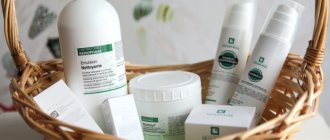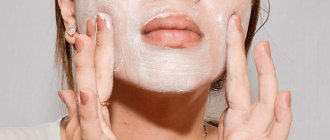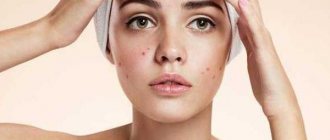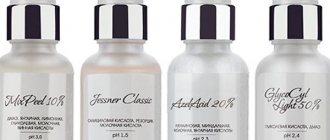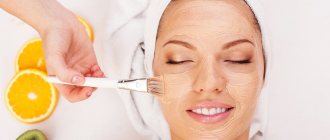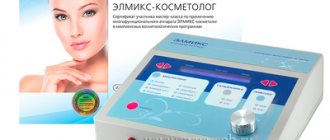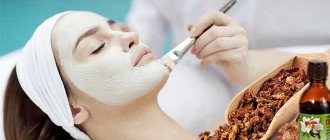Updated: 02/19/2021 18:42:27
Expert: Daria Alekseevna Litvinova
*Review of the best according to the editors of expertology.ru. About the selection criteria. This material is subjective in nature, does not constitute advertising and does not serve as a purchase guide. Before purchasing, consultation with a specialist is required.
A facial care program necessarily includes a peeling procedure - removing dead epidermal cells to renew the skin. This is damage to the upper layer, which is perceived by the body as a signal for regeneration. What is the indication for using this procedure?
Here are the main ones:
- dark spots;
- scars, post-acne, scars;
- dull skin;
- wrinkles, sagging, deterioration of relief;
- problematic skin with acne.
There are several types of peeling to achieve different cosmetic effects. They are superficial, middle and deep and differ in the method of impact. The experts of our magazine, together with cosmetologists and dermatologists, have selected the best facial peels that will help preserve the beauty and youth of the skin.
The history of facial peelings
Facial peeling (exfoliation) is a cosmetic procedure aimed at exfoliating (removing) the upper keratinized layer of the epithelium. Translated from English, this term means “removing the husk,” which most accurately reflects the essence of the method. By cleansing the skin of dead cells, the effect of renewal and rejuvenation is achieved, the complexion improves, and mechanisms of accelerated cell regeneration are launched.
The history of facial skin resurfacing goes back a long way. This is the oldest known cosmetic technique. It was first used in Ancient Egypt and Mesopotamia. Exfoliating mixtures in those days included crushed minerals and pieces of fruit seeds. The prototype of modern chemical peelings of the facial skin were compositions based on fruit and lactic acids, which beauties of ancient times treated their skin with. In the Middle Ages, more complex technologies and recipes using wine and grape juice appeared. Tartaric acid played the role of an active component that dissolves dead cells. But if used inappropriately, such products could cause a chemical burn to the skin of the face. Even then, researchers realized that after treatment with acidic compounds the skin should not be exposed to sunlight.
The latest research has discovered new properties of acids and their combinations for safe and effective facial peeling procedures. The modern beauty industry offers an extensive arsenal of products. Some of them effectively exfoliate dead cells mechanically (scrubs). Others improve the appearance of the skin using chemical peels. Still others start the regeneration process, additionally rejuvenate and saturate the skin with nutritional components. Many types of peelings for the face and body perform not only a cleansing, but also a healing function. They help get rid of comedones (blackheads), acne, age spots and other dermatological problems.
Professional peelings: mechanism of action
The skin of the face is thin and delicate. It is most susceptible to the influence of adverse weather factors and ecology, which trigger age-related changes. Therefore, it is so important to provide proper care and prevent early withering and aging processes. The use of nourishing and moisturizing masks and creams benefits the skin, but it cannot trigger active cell renewal and regeneration. This effect is achieved by a more radical procedure – exfoliation (peeling) of the dermis.
The essence of the method is to remove the top, keratinized cells and cleanse the facial skin. During the cleaning process, intensive exfoliation of the stratum corneum occurs, which stimulates deeper cells to actively regenerate. Their accelerated division helps to heal and rejuvenate the epidermis, even out the tone, and eliminate minor defects. Young skin, freed from dead cells, intensively absorbs and absorbs nutrients, moisture and oxygen.
As a result, the cell renewal mechanism is launched, metabolic processes are activated, and the synthesis of collagen and elastin fibers is improved. This is necessary to maintain facial skin turgor and slow down the aging process.
Peeling procedure: what problems does it solve?
Exfoliation of the skin helps solve many problems:
- cleansing the facial skin of dead cells, impurities, sebaceous plugs;
- improve the penetration of creamy textures that saturate epithelial cells with nutrients and oxygen;
- moisturize and refresh the upper layer of the epidermis;
- improve complexion, even out skin tone and texture;
- prevent the formation of new wrinkles;
- restore lymphatic drainage, eliminate swelling;
- activate the production of collagen fibers;
- prevent the development of inflammatory processes on the skin;
- slow down age-related changes;
- eliminate skin defects (pimples, comedones), lighten age spots;
- activate cell renewal, accelerate the processes of regeneration and restoration of the skin.
A properly performed cosmetic procedure rejuvenates the skin, making it firmer, tighter and healthier. The positive effect is achieved by exfoliating the top layer of keratinized cells, which create an obstacle to the timely regeneration and renewal of the skin.
Impact zones
Peels are recommended for treating the following areas:
- Face – exfoliation is used to correct age-related changes and improve the appearance of the skin.
- Body – in combination with other procedures, body peeling helps get rid of cellulite, stretch marks, and improve the elasticity and firmness of the skin.
- Hair – the procedure is used to cleanse the scalp of dandruff, manifestations of seborrhea and dermatitis. In combination with massage and nourishing masks, it improves cell nutrition, blood circulation and metabolic processes, and stimulates hair growth.
The procedures must be performed by a professional cosmetologist who will correctly assess the condition, skin type, individual characteristics of the patient, and possible contraindications.
Classification of facial peels
All procedures with a cleansing effect in cosmetology are divided into two categories - according to the degree of depth and type of effect.
The depth of penetration depends on the thickness of the stratum corneum and the general condition of the skin. Taking this parameter into account, facial peeling can be:
- superficial;
- average;
- deep.
Based on the type of impact, facial skin peels are:
- mechanical;
- chemical;
- hardware.
Each of these options has its pros and cons, application features, indications and contraindications. Let's take a closer look at the different options for the popular procedure.
Tips from cosmetologists
- The first procedure is recommended to be carried out with the participation of a professional master. The correct algorithm for applying the peeling product, the sequence of actions and time of use will be strictly regulated and will serve as a starting point for further use at home.
- It is necessary to select a peeling for the face not only based on the personal characteristics of the skin, the type of acid, its percentage, but also the form of release of the product. It can be a gel, cream or liquid composition. The use of peeling for home use is based on a natural rule - the denser the structure of the applied substance, the softer its effect. Therefore, the liquid form of release allows you to penetrate deeper into the layers of the epidermis, but it becomes more difficult to control its movements.
- Peeling products for home use should be based on natural, beneficial elements that will protect the skin from additional aggressive external influences.
Numerous reviews and practice have shown that professional peelings at home and in the salon can be a fairly effective procedure only if the composition is selected correctly, taking into account the personal characteristics of the skin.
Rating
Types of peelings in cosmetology
Superficial facial peeling
This is the most comfortable and gentle option for cleansing the skin of the face and body, since the active substances do not penetrate deeply, providing only exfoliation of the top layer of skin.
To cleanse the skin mechanically, a variety of natural compositions with small solid particles that act as an abrasive are used. These are ground coffee beans, fruit seeds, crushed corals, rice grains, etc. A well-proven option is mechanical superficial facial peeling using brushes (brossage). Of the hardware methods for carrying out superficial cleansing of facial skin, the cavitation (ultrasonic) peeling method is best suited.
For superficial chemical peels of the face, preparations with fruit acids or compositions based on alpha hydroxy acids are used. They gently exfoliate cells without causing burns or irritation. A wide variety of acid compositions makes it possible to choose the best option for cleansing your facial skin. For procedures, malic, citric, lactic, tartaric, and mandelic acid are most often used.
Compositions based on retinoic, salicylic, and glycolic acid are popular. Intensive cell renewal, improved blood circulation and metabolic processes are promoted by superficial peelings of the facial skin with ascorbic or azelaic acid.
A low concentration of exfoliating solutions does not cause complications, pain and does not require rehabilitation time.
Indications
A gentle superficial peeling procedure is ideal for young skin. It refreshes the complexion well, brightens pigmented areas, dissolves sebaceous plugs in pores, eliminates inflammatory processes that provoke the appearance of acne. In addition, this method allows the active substances of other cosmetics to quickly penetrate the structure of the epidermis. Other indications include deterioration of complexion, post-acne, fine wrinkles, and a slight decrease in skin turgor. The superficial facial peeling procedure is ideal for young skin (up to 30 years).
Medium skin peeling
This type of exposure is based on the use of aggressive acidic compounds that penetrate the middle layers of the dermis. As active substances, preparations based on acids of higher concentration (trichloroacetic, salicylic, glycolic) are used.
Median exfoliation can also be performed mechanically. This procedure is called diamond peeling of the facial skin and is performed using special equipment equipped with diamond-coated brushes.
The midfacial peeling procedure is quite painful. After it, proper skin care is necessary during the process of rehabilitation and recovery. In one course you can do from 2 to 5 procedures, taking into account the skin type and the existing problem. Repeated cleansing sessions are allowed no earlier than six months later. There are also age restrictions. This type of exposure is not recommended for girls under 30 years of age.
Indications for medium facial peeling:
- increased keratinization of the epidermis (hyperkeratosis);
- loss of elasticity, appearance of deep wrinkles, sagging skin and other age-related changes;
- skin defects - acne, scars at the site of removed pimples (post-acne), age spots;
- manifestations of rosacea (red vascular network).
By acting at a certain depth, medium facial peeling can smooth out wrinkles, refresh the face, improve collagen production, narrow enlarged pores and even get rid of scars and flat warts.
Deep peeling of face and body
The active ingredients of chemical peels penetrate deep into the reticular layer of the dermis. For the chemical procedure of deep facial peeling, strong, aggressive acids of high concentration are used (trichloroacetic, phenolic). They also use mechanical dermabrasion or laser resurfacing.
This is the most painful and traumatic type of deep peeling of the face and body, which requires a cosmetologist to have a lot of experience, high qualifications and special care when carrying out the procedure. The deeper the effect on the dermis, the longer the period of rehabilitation and healing of the skin. Any mistake can lead to skin damage and complications. However, it is this type of deep peeling that gives the best aesthetic result and a pronounced rejuvenation effect.
Indications for deep peeling for face and body skin:
- removal of deep expression wrinkles;
- smoothing skin texture;
- elimination of rough scars and cicatrices;
- smoothing stretch marks;
- lightening of areas of hyperpigmentation.
The result of a deep facial peeling procedure is comparable to non-surgical cosmetic facelift techniques. The effect of lifting, rejuvenating and cleansing the skin lasts for a long time. But the rehabilitation period is also long – it will take at least 8 weeks for the skin to completely heal. When performing phenol facial peeling, restoration of the skin takes from 8 to 12 months. All this time, the skin needs to be taken care of, protected from ultraviolet radiation, and treated with wound-healing and antibacterial agents that prevent infection of the wound surface.
Contraindications
General contraindications that limit the possibility of using any type of facial peeling include:
- damage to the skin in the treatment area (scratches, abrasions, wounds);
- exacerbation of any dermatological diseases;
- the presence of inflammatory processes on the skin;
- acute stage of infectious or colds with hyperthermia (high temperature);
- individual intolerance to peeling compositions;
- herpetic infection,
- demodicosis (skin mite);
- mental disorders;
- oncological diseases;
- pregnancy, breastfeeding period.
Deep facial peeling with phenolic acid is a procedure that requires special care and attentive attention to the patient’s health. Phenol or carbolic acid is a highly toxic substance. A procedure using this component cannot be prescribed for pathologies of the liver and kidneys, diseases of the heart and blood vessels. In addition, any type of deep peeling of the facial skin (regardless of the method of execution) is prohibited if there are problems with the hematopoietic system and bleeding disorders.
User rating
Bielita Mesopeeling roller MEZOcomplex Deep cleansing
1
Natura Siberica Natural & Organic Gentle
A'PIEU Apple Acid Visible Peeling Gel
Bielita Micropeeling Stop Acne cleansing
7DAYS peeling roller for the eccentric and playful with Ripe Mango
Holy Land Lactolan Peeling cream
Limoni Fresh skin Amazing apple facial peeling gel
Mizon peeling gel Therapy Apple smoothie peeling gel
G9SKIN Grapefruit Vita Peeling Gel
Grandma Agafya's Recipes Renewing
Deoproce Premium Green Tea Peeling Vegetal
Frudia peeling discs Green grape Pore Peeling Pad exfoliating with green grapes
Black Pearl Precious Oils
Skinlite Exfoliating Gel with Fruit Acids
Gemene fruit acids for peeling and regeneration
Methodology
Let's consider the technique of performing the most popular and sought-after procedures:
Mechanical peelings for facial skin
- Coral. The basis of the cleansing compositions are the smallest particles of coral, Dead Sea salts, essential oils, and exotic herbs. Before applying the drug, the facial skin is thoroughly cleansed of dirt and makeup residues. The powder base is diluted with water to the required consistency and applied to the skin with light massage movements. The procedure is quite comfortable, but for those with delicate skin it may cause mild pain. This type of mechanical peeling for the face helps eliminate enlarged pores, acne, and lighten areas of pigmentation. After the procedure is completed, the remnants of the drug are washed off with cool water, and a soothing mask is applied to the facial skin.
- Diamond. It is performed with special diamond-coated nozzles. This spray acts as an abrasive that effectively exfoliates the top layer of facial skin. The mechanical peeling procedure is useful for the appearance of wrinkles and decreased skin turgor. Helps fight age-related changes, correct the functioning of the sebaceous glands, cleanse the skin and clogged pores.
- Brossage. This is a completely safe and low-traumatic type of mechanical superficial facial peeling, during which special rotating brushes provide cleansing of the skin. The skin of the face should first be cleansed and steamed over a container of hot water to open the pores as much as possible. Then a scrub with small hard particles is applied to the face and treated in a circular motion with a special attachment with soft brushes. At the final stage, it is recommended to apply a moisturizing gel and polish the skin along the massage lines with a pumice pad. At the end of the procedure, a mask with a soothing effect is applied to the face.
- Dermabrasion. This is the most traumatic option for mechanical peeling for the face. But it provides the best result and allows you to solve serious cosmetic problems (remove scars and scars on the face and body). The session takes place using local anesthesia. After preliminary cleansing of the skin, the cosmetologist applies markings to the face or body and selects the necessary attachment. The treatment area is frozen with a cooling spray so that dead scales peel off more easily, and then passed through with a rotating nozzle. At the end of the session, the treated area is covered with a sterile bandage. The duration of the procedure is 15-20 minutes.
Chemical facial peels against wrinkles
- Enzymatic. One of the most gentle chemical superficial facial peels. The active substances are special enzymes that are applied to previously cleansed skin for 20 minutes. Procedures using enzymes or safe lactic acid can be done independently at home. Enzyme superficial peeling improves complexion, tones, refreshes, ideal for young skin.
- Fruit. Chemical facial peeling based on fruit acids (tartaric, malic, citric, etc.) works on the surface or in the middle layers of the skin. The application technique is similar - clean facial skin is treated with special compounds, left for a certain time, then the acid is neutralized with an alkaline solution, washed off and soothing agents are applied. The exposure time is determined by the cosmetologist. The duration of the procedure depends on the type of drug used, the condition and type of skin.
- Salicylic. This type of chemical peeling is often used for therapeutic purposes. Helps fight acne, normalizes the functions of the sebaceous glands, dries and disinfects the skin, and narrows enlarged pores. The duration of exposure and the number of procedures are determined by a dermatologist.
- Phenolic. Deep chemical peeling of the face, which is performed only when indicated, using anesthesia. This is a traumatic, painful procedure with a long recovery period. Recommended to eliminate pronounced age-related changes, stretch marks and hypotrophic scars. Phenol or carbolic acid causes a chemical burn to the skin. After healing, an effect comparable to plastic surgery for a facelift is observed. The peeling mixture is applied in stages to clean, dry skin, pre-treated with ethyl alcohol. The composition hardens on the face in the form of a mask. The duration of the procedure is from 40 minutes to two hours. At the end of the session, the mask is removed along with the top layer of epithelium. In the future, it is necessary to treat the skin with antiseptics, painkillers and moisturizers. This chemical peeling procedure has many contraindications, a high risk of complications and a very long rehabilitation period (can reach 12 months).
Hardware peelings
- Ultrasonic facial peeling. The effect on the skin occurs due to ultrasonic waves of different frequencies. A cleansing gel is first applied to the face, which, under the influence of sound waves, turns into a fine emulsion. The active substances of the emulsion effectively dissolve impurities and remove sebaceous plugs from the pores. The procedure promotes delicate exfoliation of dead epidermal cells, eliminates comedones, and evens out complexion. This is a completely comfortable and painless technique that does not cause side effects and does not require long-term rehabilitation.
- Laser resurfacing. Carbon dioxide or erbium lasers are used to cleanse the face and cleanse the skin. Thermal radiation effectively evaporates dead cells, easily penetrates to a given depth, activates metabolic processes, stimulates the production of collagen structures, improves blood circulation, and restores skin elasticity. Laser facial peeling is a completely safe procedure based on modern technologies. Does not cause complications, is suitable for eliminating scars, stretch marks, deep wrinkles, provides a lifting and rejuvenating effect on the skin.
- Cryopilling. This is one of the most comfortable and painless procedures. Coolant (liquid nitrogen) is applied to the skin for just a few seconds. Under the influence of ultra-low temperatures, the surface layer of the skin is frozen, followed by exfoliation. Such short-term freezing stimulates epidermal cells to quickly renew, activates the immune system, and provides an antiseptic and antibacterial effect. Rehabilitation takes only 2-3 days; complete restoration of the skin takes 1-2 weeks. The procedure helps smooth out the signs of photoaging and fading, evens out the appearance, eliminates fine wrinkles, fights acne, enlarged pores and manifestations of demodicosis.
When choosing the best peeling option for the face and body, you must take into account the condition of the skin and age. For young skin (up to 25 years), it is best to use the most gentle procedures based on enzymes, lactic or fruit acids.
Older ladies (from 30 to 40 years old) are recommended to select formulations with a higher concentration of chemicals or do mechanical cleansing (microdermabrasion). For more mature skin, with pronounced age-related changes (after 45 years), procedures with a deep degree of penetration are necessary. This effect can be provided by aggressive chemical compounds or hardware methods aimed at accelerating cell renewal, moisturizing, saturating tissues with oxygen, and slowing down age-related changes.
Acne vulgaris: treatment with Azelik® gel
Peeling is only an auxiliary measure for acne vulgaris; treatment should be prescribed by a dermatologist, not a cosmetologist. One of the drugs used in the treatment of mild to moderate acne vulgaris is Azelik®5 gel. Its main active ingredient is azelaic acid5. The drug has the following properties5:
- exhibits antimicrobial activity against Propionibacterium acnes and Staphylococcus epidermidis;
- helps normalize keratinization processes;
- helps reduce the level of fatty acids;
- helps relieve inflammation by reducing the metabolism of neutrophils and their production of free radical forms of oxygen.
Azelik® gel should be used twice a day, applied to clean, dry skin5.
*acne
Which drug should I choose?
The choice of professional facial peeling products should be entrusted to a cosmetologist. The range of preparations for cleansing procedures is huge. Particularly popular are compositions based on the following components:
- lactic acid;
- glycogel acid;
- ascorbic, salicylic acid;
- fruit acids (malic, citric).
The excipients include brightening and moisturizing components, extracts of berries, fruits, green tea, enzymes, chitosan, and natural oils.
High-quality and effective facial peelings are produced by well-known cosmetic brands from Israel, Spain, France, and Germany. Russian products from the Natura Siberica company, which produces various types of glycolic and fruit peels, are also deservedly popular. The most important thing is to choose the right product that is ideal for your skin, will not cause irritation or adverse reactions, and will help effectively solve existing problems.
Separately, it is necessary to mention problem skin, because exfoliation is not only a cosmetic, but also a therapeutic procedure. It is used to eliminate acne, cleanse clogged pores, normalize the functions of the sebaceous glands, and prevent inflammatory processes. In this case, salicylic acid-based preparations are used during the procedure. It has a powerful keratolytic effect - exfoliates dead cells, dries, and provides an anti-inflammatory and antiseptic effect.
Russian industry
Professional peelings of domestic production specialize in producing a whole series of inexpensive products with chemical acids for all skin types, cold hydrogenation gels, and enzyme preparations.
The top 10 facial peels for home use from Russian brands are presented by Medical Collagene 3D. The products were developed with the participation of scientists from the Research Center of the Moscow Medical Academy named after. THEM. Sechenov.
- Enzyme “Anti-acne” for problem skin can eliminate excess shine, cleanse pores, even out complexion, has an anti-inflammatory effect, moisturizes and nourishes, preventing the appearance of new inflammatory formations.
- Light glycolic peeling for home use with chitosan is characterized by gentle removal of dead skin cells. It reduces fine wrinkles, tightens and cleanses pores.
- For normal and combination skin, use an enzyme facial peeling product that gets rid of blackheads and stimulates the synthesis of collagen and elastane.
- “SEBO NORM” of the same brand will help you cope with oily skin at home, providing comprehensive care: it helps eliminate toxins, reduces the secretion of the sebaceous glands.
- For problematic skin, it is recommended to use an effective peeling with collagenase, which removes toxins and saturates with microelements.
- A highly effective dual-action formula is present in the micro-peel for the face, which contains sea minerals, macadamia oil, shea butter, and also combines the properties of mechanical and biological action.
- In the fight against pigmentation and freckles, Natural Peel with papain and shiso oil is recognized as the best domestic professional peeling.
- The delicate enzymatic complex Medical Collagene 3D allows you to carry out the cleaning procedure all year round.
- Enzyme with papa and grape seed extract helps strengthen the walls of blood vessels, brightens, evens out skin tone.
- Professional peeling gel “EASY PEEL 5%” helps retain moisture, maintaining the thickness and structure of the stratum corneum.
Peels from the French laboratory Renophase stand apart in the global industry. They do not require pre-peeling preparation or rehabilitation period.
Pros and cons of ailing for the face
Any type of facial peeling has its advantages and disadvantages, which should be discussed with a cosmetologist before starting cleansing courses.
Mechanical grinding gives a noticeable rejuvenating effect. The procedure is ideal for smoothing skin texture, eliminating hyperpigmentation and age-related changes. The disadvantages include pain when performing dermabrasion and a rather long recovery period, during which the risk of infection cannot be excluded.
Chemical peeling of the face and body using low-aggressive means has virtually no disadvantages, provides a visible rejuvenating effect, and does not cause complications. When using high concentration acidic compounds, there is a risk of chemical burns. Another disadvantage is that medium and deep chemical peeling of the facial skin requires a long recovery period (from 2 to 12 months).
Hardware procedures (ultrasound, laser facial peeling) are considered the safest and most painless, do not cause side effects, and are easily tolerated. The only downside is the high cost of the procedures.
Reviews
Sarah, 30 years old
“I have dry skin and enlarged pores. I tried laser resurfacing, and in the fall - fruit peeling. Now the condition of the skin has improved (perfectly smooth, without rashes and redness), the face has changed
.
Maria, 29 years old
“Girls, I want to share with you. The cosmetologist recommended carbon peeling, I am pleased with the result. Now even minor signs of aging are not visible. There is no puffiness or dryness, the pores have narrowed, the tone has evened out. I had a little redness immediately after the procedure, but after 3 days it went away. Everything is good, but the price is not cheap - that’s the only negative.”
Irina, 45 years old
“I had ABR peeling done in a private clinic. There were 6 procedures in total, which takes a lot of time. The sensations are painful (tingling, burning), but tolerable. The result exceeded all expectations. The complexion has evened out, the pores have narrowed, the wrinkles have smoothed out. Even my friends noticed the changes. I am very pleased."
Price for peelings
The cost of a full course depends on the type of facial peeling, the drugs or equipment used, the qualifications of the cosmetologist, the condition of the skin, treatment areas, and the number of procedures. Here are the average prices for various facial cleansing techniques:
- coral peeling – from 2,000 to 9,000 rubles;
- dermabrasion - from 1500 to 6000 rubles;
- retinoic peeling – from 4500 to 8000 rubles;
- cryopilling – from 2000 to 4000 rubles.
- enzyme peeling – from 5,000 to 7,000 rubles;
- laser resurfacing – from 6,000 to 15,000 rubles.
To find out more about what the cost of the procedure consists of and how many sessions will be required for a course of skin cleansing and rejuvenation, it is recommended to consult with a cosmetologist.
Precautionary measures
Precaution is related to the characteristics of the body. They must be taken into account when peeling, since serious health problems are possible. Need to consider:
- intolerance to components;
- adherence to allergic reactions;
- skin diseases;
- various rashes;
- period of pregnancy and lactation;
- chronic herpes.
If you have health problems, cleaning can only be done by a cosmetologist. Otherwise, burns and scars are possible.


